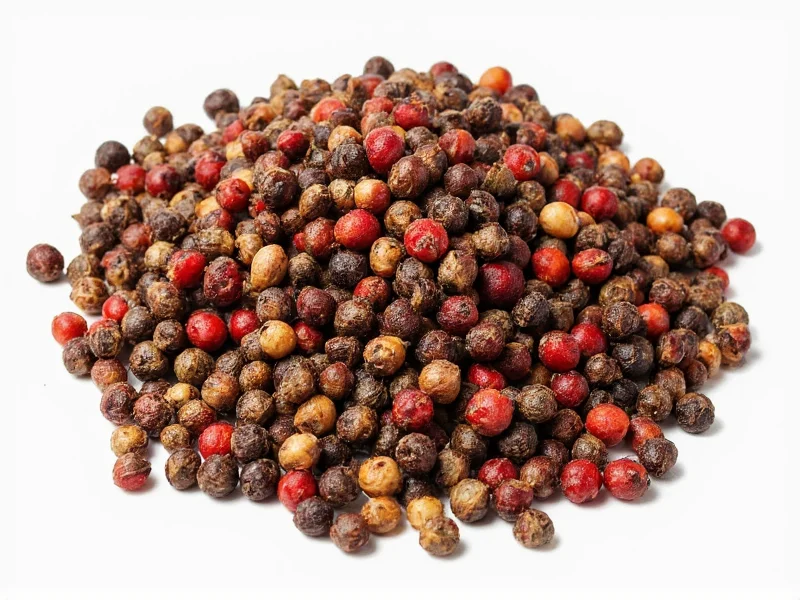Understanding peppercorn flavor goes beyond simply recognizing it as ‘pepper taste.’ This ancient spice offers one of the most nuanced flavor profiles in the culinary world, with subtle variations that can dramatically impact dish composition. Unlike synthetic pepper flavors, authentic peppercorn delivers a multi-dimensional experience that evolves from initial floral notes to a lingering warmth.
The Science Behind Peppercorn Flavor
Peppercorns contain over 50 different aromatic compounds that contribute to their distinctive flavor profile. Piperine (5-9%) provides the characteristic heat, while beta-caryophyllene contributes woody, spicy notes. Limonene adds citrus undertones, and pinene delivers subtle pine-like freshness. This complex chemical composition explains why freshly ground peppercorns offer significantly more nuanced flavor than pre-ground alternatives—volatile compounds dissipate within minutes of grinding.
Unlike chili peppers that create immediate, surface-level heat, piperine in peppercorns produces a gradual warmth that builds slowly and lingers longer. This unique sensory experience makes peppercorn flavor particularly valuable in complex dishes where balance and progression of flavors matter.
Comparing Peppercorn Varieties and Their Flavor Profiles
Despite coming from the same plant species (Piper nigrum), processing methods create dramatically different flavor experiences. Understanding these differences is essential for proper culinary application.
| Type | Processing Method | Flavor Characteristics | Heat Level (Scoville) | Best Culinary Uses |
|---|---|---|---|---|
| Black Peppercorn | Sun-dried with outer layer intact | Robust, earthy, complex with pine and floral notes | 10,000-30,000 | Meat rubs, sauces, soups, roasted vegetables |
| White Peppercorn | Soaked to remove outer layer, then dried | Milder, cleaner, slightly fermented notes | 5,000-15,000 | Cream sauces, light-colored dishes, Chinese cuisine |
| Green Peppercorn | Harvested unripe, freeze-dried or brined | Fresh, herbal, slightly fruity | 2,000-5,000 | Fish, salads, Thai and French cuisine |
| Pink Peppercorn | Not true peppercorn (from Schinus tree) | Berry-like, floral, mild heat with resinous notes | 100-500 | Desserts, fruit dishes, finishing spice |
Unlocking Peppercorn Flavor in Cooking
Maximizing peppercorn flavor requires understanding when and how to incorporate it into dishes. Whole peppercorns release flavor gradually during cooking, making them ideal for stocks, braises, and pickling solutions. For immediate impact with complex top notes, freshly ground pepper added at the end of cooking preserves volatile aromatic compounds.
Chefs specializing in spice-forward cuisine emphasize that peppercorn flavor interacts differently with various food components. In fatty dishes, piperine binds with lipids, creating a smoother heat distribution. In acidic preparations like vinaigrettes, the heat sensation intensifies as pH decreases. Understanding these interactions helps create balanced dishes where peppercorn flavor enhances rather than dominates.
Peppercorn Flavor Pairings and Complementary Ingredients
Certain ingredients naturally complement peppercorn flavor, creating synergistic taste experiences. Citrus elements like lemon zest brighten peppercorn’s earthiness, while dairy products like cream or butter mellow its heat while preserving flavor complexity. For black peppercorns specifically, complementary pairings include:
- Proteins: Beef, lamb, duck, and game meats benefit from black peppercorn’s robust profile
- Vegetables: Mushrooms, potatoes, and root vegetables absorb peppercorn flavor beautifully
- Herbs: Rosemary, thyme, and sage enhance peppercorn’s woody notes
- Liquids: Red wine, beef stock, and dark vinegars create complex flavor bases
White peppercorn shines in delicate preparations like béchamel sauce or seafood dishes where visual appearance matters. Green peppercorns pair exceptionally well with fish, chicken, and in creamy sauces where their fresh, herbal notes can shine.
Common Misconceptions About Peppercorn Flavor
Several myths persist about peppercorn flavor that can lead to suboptimal culinary results. Many believe ‘hotter is better,’ but excessive heat overwhelms peppercorn’s nuanced flavor profile. The ideal amount varies by dish—a delicate cream sauce might need just a few grinds, while a hearty beef stew could handle more.
Another misconception is that all peppercorns are interchangeable. While substitution is possible in emergencies, each variety brings unique flavor components that affect the final dish. Understanding these differences helps home cooks and professional chefs alike create more sophisticated flavor profiles.
Maintaining Peak Peppercorn Flavor
Peppercorn flavor degrades significantly when exposed to air, light, and moisture. For optimal flavor preservation:
- Store whole peppercorns in airtight containers away from heat sources
- Grind immediately before use—pre-ground pepper loses 50% of volatile compounds within 15 minutes
- Avoid refrigeration, which introduces moisture that accelerates flavor degradation
- Buy from reputable sources with high turnover to ensure freshness
Properly stored whole peppercorns maintain peak flavor for 2-3 years, while pre-ground pepper loses significant flavor within months. The simple act of grinding your own peppercorns moments before use transforms ordinary dishes into extraordinary culinary experiences.
Exploring Global Peppercorn Traditions
Different culinary traditions have developed unique approaches to utilizing peppercorn flavor. In French cuisine, the classic steak au poivre features coarsely cracked black pepper creating a crust that delivers intense flavor with each bite. Indian cuisine often uses black pepper in combination with other spices in garam masala, where its warmth complements cardamom and cloves.
Chinese cooking frequently employs white pepper in soups and dumpling fillings for its cleaner heat profile that doesn’t discolor light-colored dishes. Understanding these cultural applications provides valuable insights into maximizing peppercorn flavor in various culinary contexts.











 浙公网安备
33010002000092号
浙公网安备
33010002000092号 浙B2-20120091-4
浙B2-20120091-4